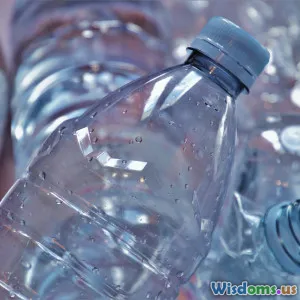
Why Microplastics in Drinking Water Should Concern You Right Now
8 min read Explore why microplastics in drinking water are a hidden danger demanding urgent attention today. (0 Reviews)
Why Microplastics in Drinking Water Should Concern You Right Now
Introduction: A Hidden Threat in Every Sip
Imagine pouring yourself a refreshing glass of water, expecting purity and safety, only to discover that you're ingesting tiny plastic particles with every sip. This scenario is becoming less hypothetical and more of a daily reality worldwide. Microplastics—microscopic bits of plastic less than 5 millimeters in size—have silently infiltrated our drinking water supplies. While once thought to be confined largely to oceans and marine animals, these insidious particles now contaminate tap, bottled, and even well water globally.
Why should you care about what’s invisible in your water? Because microplastics pose potential health risks and symbolize a broader environmental crisis that intersects with public health, water safety, and consumer choices. This article explores why microplastics in drinking water should concern you right now—delving into how they get there, their impacts, and what can be done to mitigate their threat.
What are Microplastics and How Do They Enter Drinking Water?
Microplastics are fragments resulting from the breakdown of larger plastic debris, such as bottles, bags, and synthetic clothing fibers, or they hail from intentionally manufactured microbeads found in cosmetics and cleaning agents. These particles are prevalent in the environment due to ubiquitous plastic consumption and poor waste management.
Sources Entering Water Systems
- Wastewater Treatment Plant Effluents: These plants are often not equipped to filter out microplastics. Studies reveal that up to 90% of microplastics can pass through these facilities, entering natural water bodies.
- Surface Water Contamination: Rivers and lakes are contaminated by run-off containing microplastics, which then permeates groundwater sources supplying drinking water.
- Plastic Degradation in Environment: Larger plastic litter exposed to sunlight and weather disintegrates over years into smaller microplastic particles that infiltrate soils and waters.
For example, research published in Water Research (2018) found microplastic concentrations as high as 9,000 particles per cubic meter in some freshwater sources. Bottled water testing by the Orb media found an average of 325 plastic particles per liter across international brands, demonstrating contamination is pervasive.
The Potential Health Impact: What Science Suggests
Scientific investigation into microplastic health effects is emerging but complex, given their recent discovery in drinking water.
What Happens Once Inside the Body?
Microplastics can range in size from visible fragments to nanoparticles. Smaller particles may cross gut barriers and enter the circulatory system, distributing throughout the body.
Dr. Sherri Mason, a leading researcher on microplastics at State University of New York, warns: "While we don’t know the full extent yet, early data demonstrate inflammation, cellular stress, and potential toxicity when microplastics accumulate in tissues."
Microplastics can also serve as vectors, carrying toxic chemical additives or absorbed environmental pollutants (like PCBs or heavy metals) that increase toxicity. The World Health Organization’s (WHO) 2019 report concluded that while immediate health risks are low, there is great uncertainty, emphasizing the need for precaution due to long-term exposure potential.
Real-World Insight
Animals exposed to microplastics exhibit immune disruption and reproductive issues, as seen in fish and marine mammals. Extrapolating these effects to humans raises serious concerns, especially with lifetime consumption of contaminated water.
Moreover, as plastics degrade further, nano-sized plastics can interact at the cellular level more readily, posing undefined but pressing risks.
Why This Matters Now: Increasing Exposure and Awareness
Escalating Plastic Production
Global plastic production exceeded 390 million tons annually by 2021, and projections indicate continuous growth. Without significant improvements in recycling or reduction, microplastic pollution will worsen.
Drinking Water Contamination Is Widespread
Studies show more than 90% of bottled waters analyzed contain microplastics. US tap water testing revealed microplastic contamination in 94% of samples evaluated in a 2017 Zaragoza University study.
Inadequate Regulation and Treatment
Most countries currently lack regulatory standards specifically addressing microplastics in drinking water. Wastewater treatment plants and water filtration systems are not uniformly designed to capture such small particles.
This regulatory gap means consumers unwittingly ingest these pollutants daily.
Environmental Justice Component
Communities relying on untreated or poorly treated water, particularly in low-income or developing regions, face disparate exposure risks. This raises global public health equity issues.
What Can You Do To Protect Yourself and Push for Change?
Personal Actions
- Use Advanced Water Filters: Filters with reverse osmosis or ultrafiltration technology effectively reduce microplastic content in tap water.
- Reduce Plastic Consumption: Less single-use plastic means lowered future microplastic pollution.
- Support and Prefer Glass or Metal Packaging: These reduce plastic particle shedding into bottled contents.
Advocate and Raise Awareness
- Push for Stricter Regulations: Support initiatives demanding limits on microplastics in water and improved waste management.
- Support Research Funding: Innovation is key to understanding health impacts and finding technological solutions.
- Engage Locally: Encourage community water quality assessments and infrastructure investment.
Conclusion: Time to Recognize and Respond to Microplastic Pollution in Water
Microplastics in drinking water are not a distant or abstract issue; they are a clear and present concern requiring urgent attention from individuals, regulators, and industries. Although many questions about health impacts remain unanswered, the growing evidence of contamination and potential toxicity demands precaution.
By understanding their origins, health risks, and the scale of the problem, you can make informed choices to protect yourself and advocate for systemic change. Clean, safe, plastic-free water is essential to our well-being, and safeguarding it must become a priority—starting today.
References used for this article include peer-reviewed scientific studies, WHO reports, and investigative analyses on microplastics in drinking water.
Rate the Post
User Reviews
Popular Posts





















